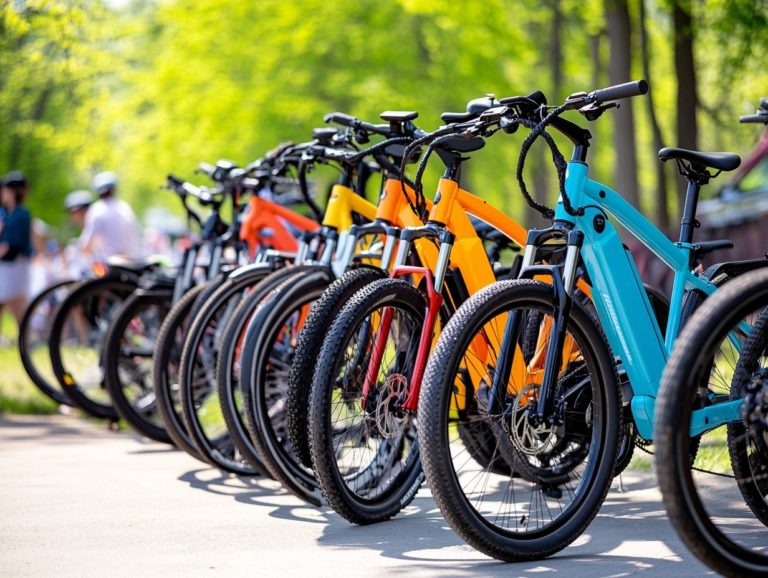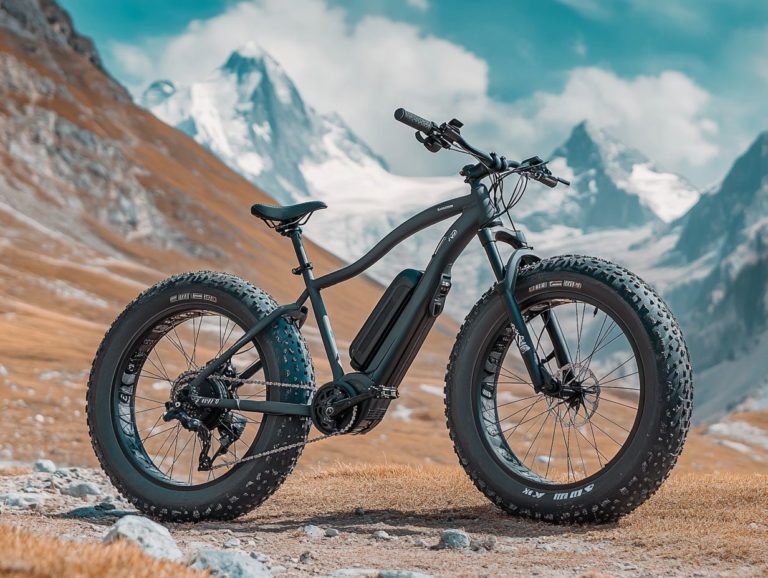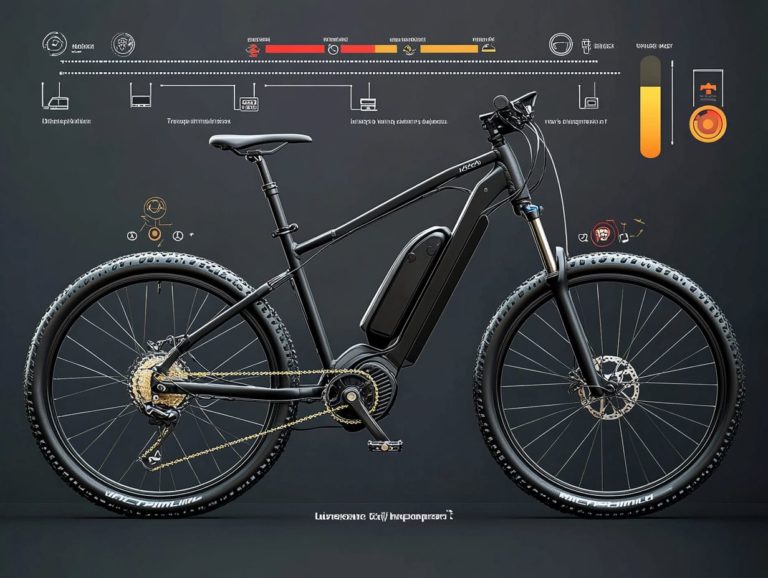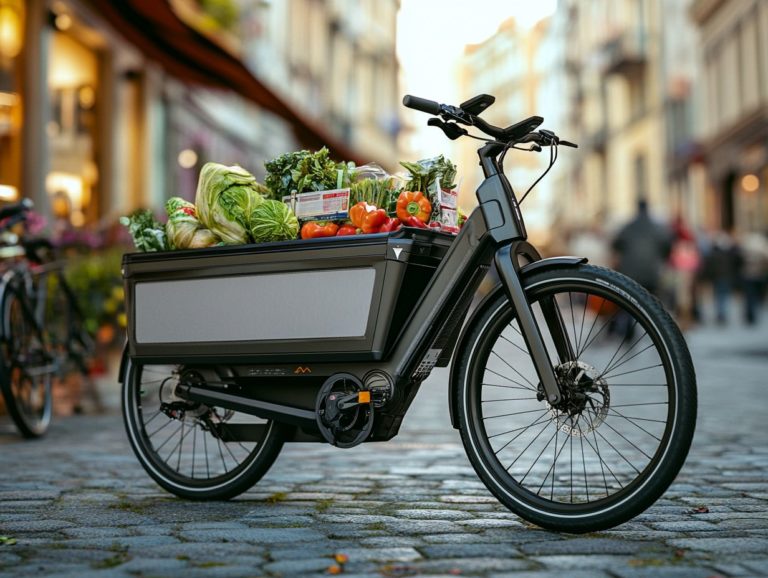The Evolution of Electric Bicycle Types Over Time
Electric bicycles have truly transformed over the years, evolving from rudimentary prototypes into an impressive array of models that cater to a wide spectrum of preferences and lifestyles.
This article invites you to explore the fascinating history of electric bikes, shedding light on their remarkable development and surging popularity in the 21st century.
Discover the various types available, including pedal-assist and folding electric bicycles, and delve into the key features that distinguish each model.
You’ll also find practical insights to help you navigate the process of selecting the perfect electric bike tailored to your unique needs.
Embark on this enlightening journey through the vibrant world of electric cycling!
Contents
- Key Takeaways:
- The History of Electric Bicycles
- Types of Electric Bicycles
- Key Features and Differences Among Electric Bicycle Types
- Factors to Consider When Choosing an Electric Bicycle
- Frequently Asked Questions
- What is the history of electric bicycles?
- How have electric bicycle types evolved over time?
- What are the benefits of electric bicycles compared to traditional bicycles?
- How have advancements in battery technology affected electric bicycles?
- What are the different types of electric bicycles available in the market today?
- How do electric bicycle types continue to evolve in the present day?
Key Takeaways:
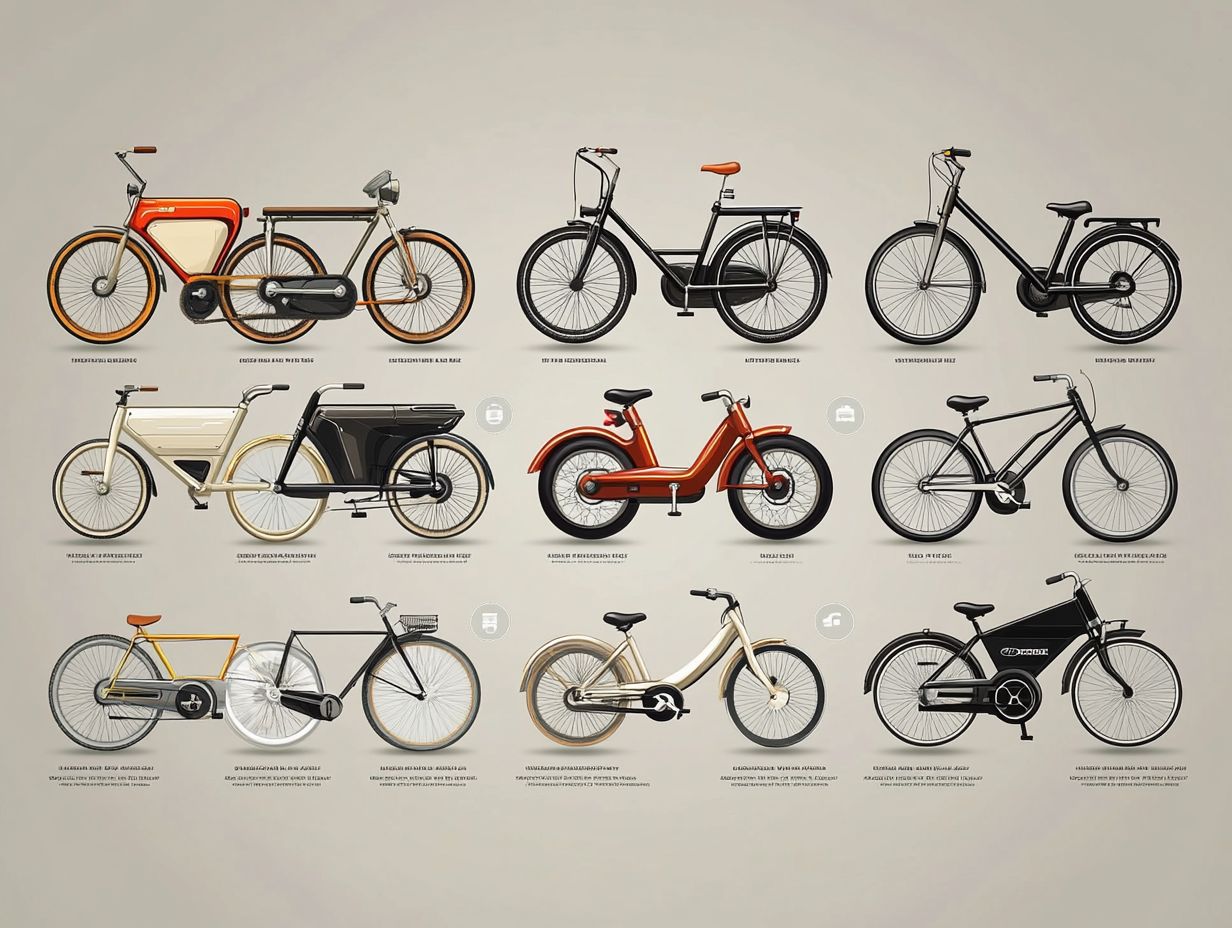
- The evolution of electric bicycles has been ongoing since the early prototypes in the late 19th century.
- Various types of electric bicycles include pedal-assist, throttle-controlled, and folding bikes.
- Consider factors like battery capacity, motor power, and budget when choosing an electric bike.
The History of Electric Bicycles
The history of electric bicycles is a captivating journey that traces back to the late 19th century, when trailblazers like Gustave Trouv and Ogden Bolton Jr. set the stage for this groundbreaking mode of transportation.
Since then, electric bikes have undergone significant evolution, shaped by advances in the 20th century and a growing awareness of environmental issues. Now, as we navigate the 21st century, modern e-bikes are gaining traction as a sustainable alternative to traditional transport systems, particularly as more people seek to understand different types of electric bicycles.
Today, electric bikes are celebrated for their incredible efficiency and fun rides, as well as their health benefits and their pivotal role in addressing environmental challenges.
Early Prototypes and Development
The early prototypes of electric bikes, crafted by innovators such as Gustave Trouv and Ogden Bolton Jr., ushered in a transformative era in personal transportation during the late 19th and early 20th centuries.
These groundbreaking models displayed designs that seamlessly blended traditional bicycle mechanics with electric power, revealing the remarkable potential of battery technology for mobility. Take Trouv’s electric tricycle, for example; it not only showcased practical functionality but also set the stage for advancements in design aesthetics. In a similar vein, Bolton introduced the concept of a rechargeable battery integrated into the bike’s framework, a move that had a lasting impact on future designs, much like the future of electric bicycle types in 2024.
As they moved beyond simple experimentation, these visionaries established a vital foundation for the evolution of electric bike technology, paving the way for innovations that would ultimately revolutionize urban commuting and personal transportation as we know it today.
Advancements and Popularity in the 21st Century
In the 21st century, the rise of electric bikes is remarkable, driven by technological advancements, health benefits, and a burgeoning global market that champions eco-friendly transportation.
These innovations, including enhanced battery capacities and cutting-edge charging technologies, offer convenience and efficiency, enabling you to cover greater distances on a single charge.
Regions like Europe and North America have wholeheartedly embraced this trend, viewing e-bikes not just as a practical commuting solution but also as a lifestyle choice.
Health-conscious individuals are increasingly gravitating toward these bikes, relishing the exercise benefits they provide while simultaneously lowering their carbon footprint. The emergence of urban cycling infrastructure and heightened environmental awareness only amplify this bicycle revolution, making e-bikes an enticing option for a diverse spectrum of users.
Ready to ride into the future? Explore our top electric bike picks today!
Types of Electric Bicycles
Electric bicycles offer a diverse range of options, each carefully designed to suit one’s unique riding preferences. Whether you choose a pedal-assist model that enhances your physical effort or a throttle-controlled e-bike for a more relaxed ride, you’re not just improving your experience; you’re also embracing environmental consciousness and sustainable transportation.
Pedal-Assist Electric Bicycles
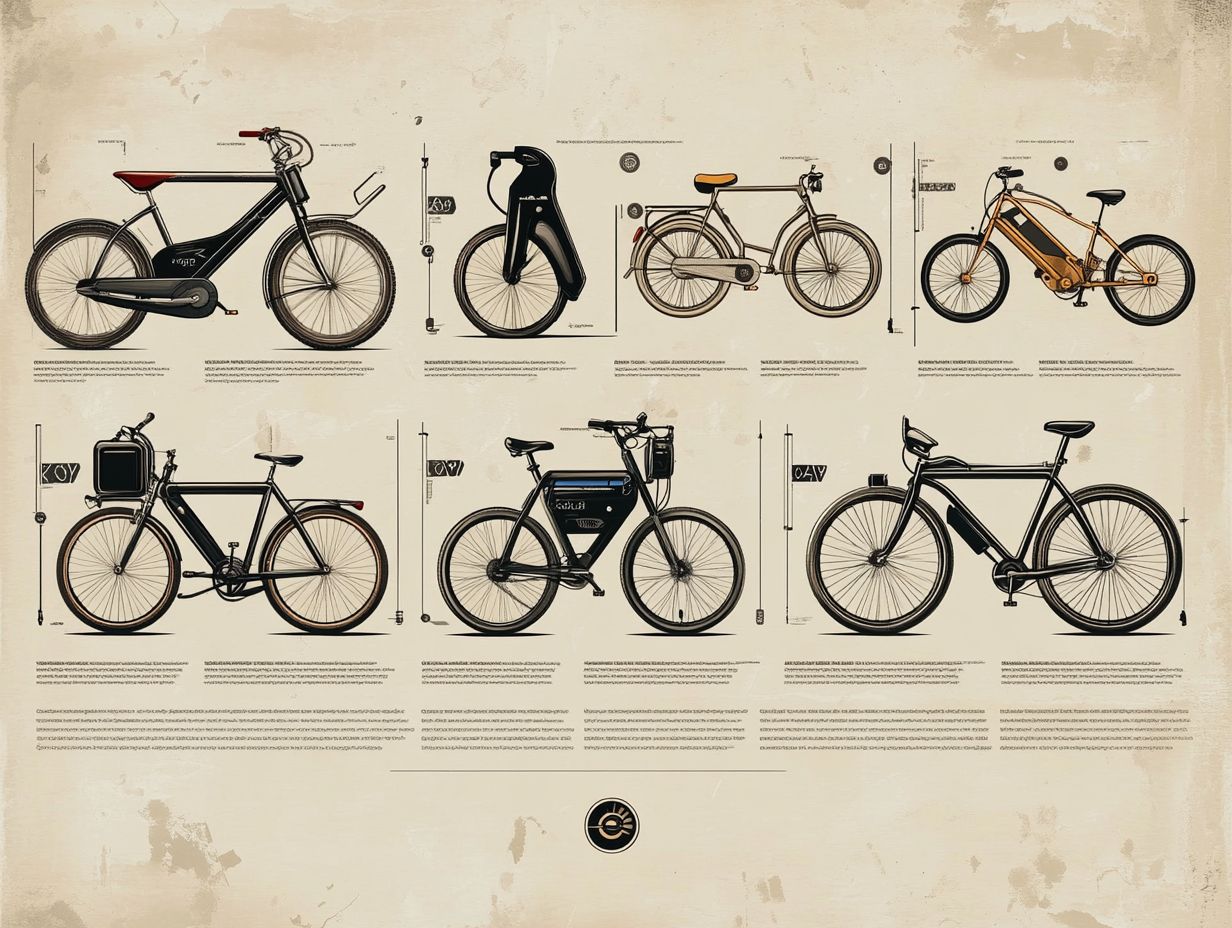
Pedal-assist electric bicycles deliver a remarkable riding experience by amplifying your pedaling efforts. They aren t just a trendy option for commuting; they also help boost your health by promoting regular physical activity.
Sensors automatically adjust to your pedaling, providing the perfect amount of help. As you navigate your surroundings, relish the fresh air and picturesque views, enjoying a workout tailored to your fitness level. This adaptability fosters a more active lifestyle without pushing you to your limits, making it ideal for individuals of all ages and fitness backgrounds.
Integrating pedal-assist e-bikes into your daily routine reduces carbon emissions and eases traffic congestion, offering a fun and eco-friendly way to get around. With urban cycling on the rise, this innovative mode of transport is reshaping how you connect with your community.
Throttle-Controlled Electric Bicycles
Throttle-controlled electric bicycles provide the luxury of speed control without the need to pedal, making them an enticing option for those who prefer a more relaxed riding experience.
Simply twist the throttle to accelerate, which is particularly advantageous for individuals with mobility challenges or those who enjoy commutes that don t require physical exertion. Unlike pedal-assist models that activate the motor only when you pedal, throttle-controlled e-bikes grant you full autonomy over acceleration. Enjoy quick bursts of speed without breaking a sweat perfect for weaving through traffic or tackling steep hills.
These bikes cater to various riding preferences, whether you’re enjoying a leisurely ride in the park or making efficient trips through bustling urban landscapes. You’ll always find your ideal way to travel.
Electric Mountain Bikes
Electric mountain bikes are designed for off-road adventures, combining the power of electric motors with rugged designs to enhance your experience on challenging terrains.
These cutting-edge bikes come equipped with high-capacity batteries that provide ample range for long rides, enabling you to conquer steep climbs and tackle technical descents with remarkable ease. Their robust frames and advanced suspension systems ensure exceptional stability and control across various trail conditions.
Features like pedal-assist modes allow you to tailor your efforts, ensuring that whether you’re a beginner or a seasoned adventurer, you can enjoy extended outings without the fatigue often associated with traditional mountain biking.
With an electric mountain bike, the thrill of exploration is amplified, unlocking new trails and creating unforgettable experiences waiting just for you.
Folding Electric Bicycles
Folding electric bicycles are designed for convenience and portability, making them the ideal solution for urban commuting and easy storage in tight spaces.
These innovative machines seamlessly combine compact design with powerful electric motors, allowing you to navigate congested city streets with ease. Their ability to fold down means you can stow them on public transportation or slide them under your office desk effortlessly.
This versatility enhances your mobility and reduces your reliance on traditional vehicles, offering a sustainable transport option for those who care about the environment. Many models now feature customizable options like adjustable seats and integrated lights for improved safety, making them a practical yet stylish choice for the modern commuter.
Key Features and Differences Among Electric Bicycle Types
Grasping the key features and distinctions among the various types of electric bikes such as battery capacity, motor power, and design functionality is crucial for making an informed choice that aligns perfectly with your unique needs.
Battery Capacity and Range
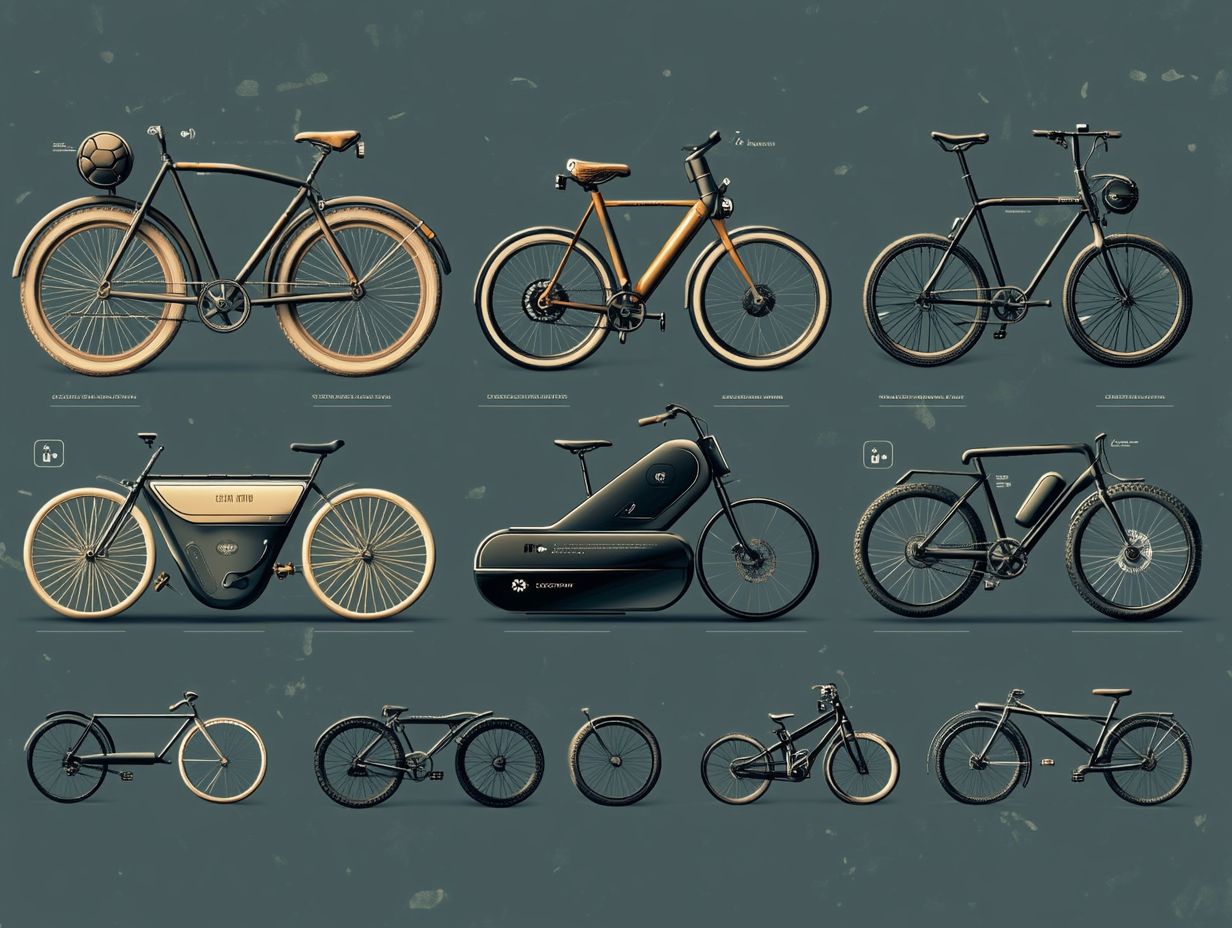
Battery capacity plays a vital role in determining the range of your electric bike. Lithium-Ion batteries are the most popular choice, thanks to their efficiency and capability to support longer rides.
The range your electric bike can achieve primarily depends on the amount of energy that a battery can store of its battery, which directly affects its power delivery over distance. While lead-acid batteries may tempt you with lower prices, they often disappoint in terms of performance and lifespan, making them less appealing for dedicated riders.
A growing network of charging stations is essential, as easy access to convenient charging solutions can significantly enhance the usability of electric bikes. For those new to this mode of transport, learning about different options is key, and you can explore electric bicycle types to find what suits your needs. As technology progresses, features like fast-charging capabilities and smart battery management systems are becoming standard, offering not just quicker charge times but also improved performance across various terrains.
By grasping the intricacies of battery technology, you can make informed decisions that elevate your biking experience to new heights.
Motor Power and Speed
Motor power is a crucial element that directly impacts the speed and overall performance of your electric bike. Different types of motors offer varying levels of power, catering to the unique riding experiences you seek.
Take high-powered models, for instance. These are often engineered for steep terrains or long-distance travel, delivering a substantial boost in speed. They’re perfect for adventurous cyclists who crave excitement and exploration.
On the other hand, commuter versions typically offer moderate power, prioritizing efficiency and a smooth ride through bustling urban landscapes.
Consider the mounting position of the motor, whether hub-mounted or mid-drive. This significantly influences how power translates into speed. Understanding this relationship enhances overall performance, ensuring that you find an electric bike perfectly tailored to your specific needs and preferences, especially with options like the rise of electric touring bicycles.
Design and Functionality
The design and functionality of electric bikes greatly enhance your riding experience, featuring elements thoughtfully crafted to cater to your diverse needs as a rider.
As you explore the various options available, consider how the choice of frame type, be it a step-through or a rigid frame, can greatly impact your ease of mounting and dismounting, especially if you have mobility challenges. The weight distribution is equally important; it affects the bike’s stability and handling, ensuring your comfort on every ride. For more insights, check out comparing different electric bicycle designs. A well-balanced electric bike allows for effortless maneuvering, enhancing both safety and your confidence on the road.
Intuitive controls and seamless technology integration simplify operation, letting you concentrate on the journey ahead rather than fiddling with settings. Each of these design elements comes together to craft a riding experience that is both enjoyable and efficient.
Factors to Consider When Choosing an Electric Bicycle
Choosing the right electric bicycle can be exciting! Think about your budget, intended use, and personal preferences.
These elements are key to finding the perfect e-bike that suits your lifestyle!
Budget and Intended Use
Establishing your budget and determining how you plan to use an electric bike are essential steps that will guide you in selecting the right type and features to meet your specific needs.
By evaluating how much you’re willing to invest, you can easily narrow down your options among various styles from commuter models designed for daily travel to rugged off-road variants ready for adventure. Each type offers unique features, such as motor capacity, battery life, and overall design, all of which play a crucial role in performance and durability. For insights into the key differences among these options, check out the 5 key differences between e-bike types.
Knowing these features can transform your riding experience, ensuring that the electric bike you select aligns perfectly with your lifestyle, whether that means enjoyable park rides or daily commutes through the bustling urban landscape. For more information, check out a guide to electric bicycle frame styles.
Personal Preferences and Needs
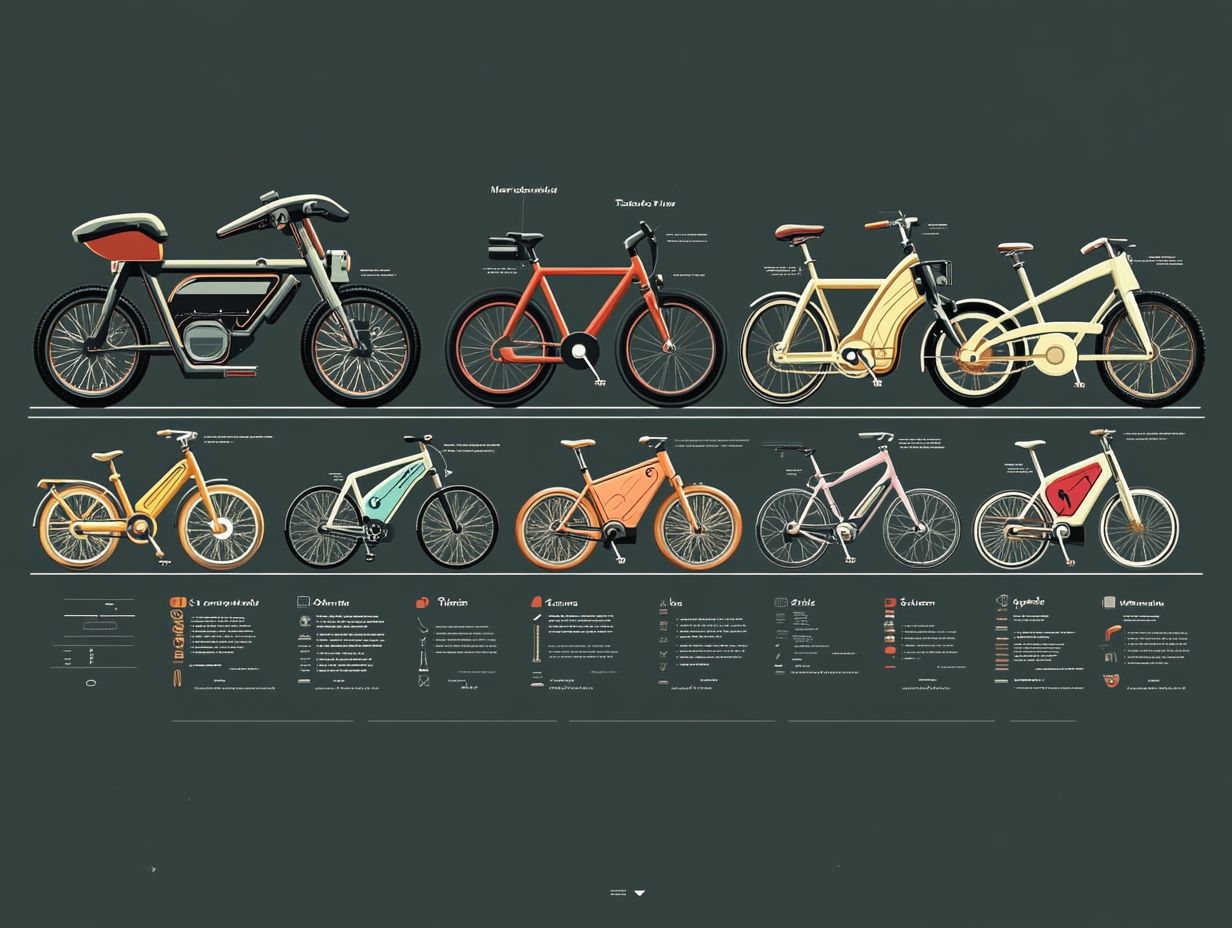
Your personal preferences and needs play a significant role in selecting the perfect electric bike, influencing everything from comfort to style and the overall ride experience.
If you prioritize comfort, look for features like an ergonomic saddle or adjustable handlebars, which can make your long commutes or leisurely trips far more enjoyable.
Aesthetics matter too; if you’re drawn to sleek, modern designs, you ll likely seek out bikes that reflect your personal style and resonate with your identity.
Your riding style will dictate the type of bike that suits your adventures, whether you prefer leisurely strolls through the park or conquering thrilling mountain trails.
By carefully considering these personal preferences, you can skillfully navigate the diverse landscape of electric bikes, ensuring a satisfying and customized experience.
Frequently Asked Questions
What is the history of electric bicycles?
Electric bicycles, or e-bikes, originated in the 1890s but gained traction in the 1990s thanks to advancements in battery technology.
How have electric bicycle types evolved over time?
Initially, electric bicycles were bulky and heavy. But with technological advancements, they have become more compact and lightweight, evolving into various types such as city, mountain, and cargo e-bikes.
What are the benefits of electric bicycles compared to traditional bicycles?
Electric bicycles offer a more efficient and eco-friendly mode of transportation, requiring less physical effort and emitting zero emissions. They also enable longer and more convenient rides, especially on hilly terrains.
How have advancements in battery technology affected electric bicycles?
The evolution of electric bicycle types over time has been significantly influenced by advancements in battery technology. The introduction of lithium-ion batteries has made e-bikes more powerful, lightweight, and capable of longer ranges.
What are the different types of electric bicycles available in the market today?
There are several types of electric bicycles available, including city e-bikes for urban commuting, mountain e-bikes for off-road adventures, and cargo e-bikes for carrying heavy loads. There are also folding e-bikes for easy storage and hybrid e-bikes for versatile use.
How do electric bicycle types continue to evolve in the present day?
With the growing demand for eco-friendly transportation, electric bicycles continue to evolve with new features and designs. Many companies are now incorporating smart technology, such as GPS tracking and app connectivity, into their e-bikes for a more convenient riding experience.

